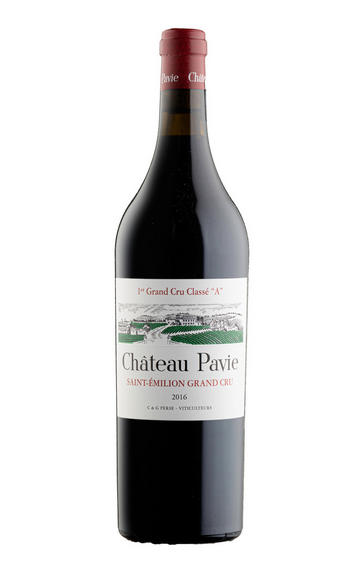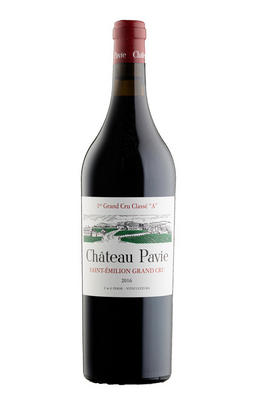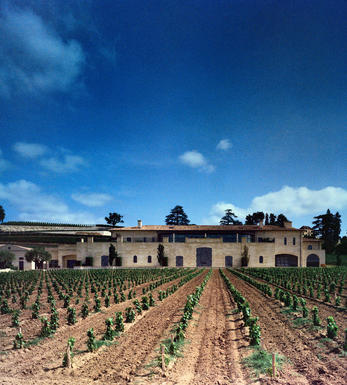
2016 Château Pavie, St Emilion, Bordeaux

Critics reviews
The 2016 Pavie is powerful and rich on the nose, and more decadent than the 2016 Angélus, featuring iodine-tinged blackberry and blueberry fruit and noticeable new oak, all lavish and sensual. The palate is medium-bodied with saturated tannins, and fleshy to the point where it masks the backbone underneath. It feels hedonistic on the finish but retains control with a wonderful spiciness that lingers on the aftertaste. Superb. Tasted blind at the annual Southwold tasting.
Drink 2026 - 2070
Neal Martin, Vinous (January 2020)
The 2016 Pavie is simply magnificent. Gracious, perfumed and exquisitely beautiful, the 2016 has it all. I can't remember seeing a Pavie with this much translucent energy and nuance. Black cherry, plum, lavender, spice and menthol all infuse this explosive, young wine with tremendous character. In the glass, the 2016 is vivid, aromatically deep and full of saline-infused energy. It is without question one of the wines of the vintage. As it turns out Gerard Perse also opened the 2008. Although the two vintages (2016 and 2008) in question are quite different in style and quality, the trajectory Pavie has taken in recent years is evident. The 2016 is a thrilling wine. That's all there is to it. The blend is 60% Merlot, 22% Cabernet Franc and 18% Cabernet Sauvignon. Tasted two times.
Drink 2026 - 2056
Antonio Galloni, Vinous (December 2016)
Lisa Perrotti-Brown - 29/03/2019
Jancis Robinson MW, JancisRobinson.com (spring 2017)
James Molesworth, Wine Spectator,(spring 2017)
James Suckling (January 2019)
Jane Anson, Decanter, (spring 2017)
About this WINE

Chateau Pavie
Château Pavie is the largest St.Emilion 1er Grand Cru Classé, with over 35 hectares of vineyards located exclusively on the St-Emilion Côtes. Pavie is situated south-east of the village of St-Emilion and its vineyards lie on a south-facing slope of the famous limestone plateau.
Pavie's vineyards are bordered by those of Château La Gaffelière and Château Pavie-Decesse. For many years the property was owned and run by Jean-Paul Valette. In 1998 Gérard Perse, who also owns Pavie-Decesse and Monbousquet, purchased it.
Pavie's wine is typically a blend of 55% Merlot, 25% Cabernet Franc and 20% Cabernet Sauvignon. Since 1998, the grapes have been fermented in spanking new wooden vats with the wine then being aged in 100% new oak bariques for 18 months. It is bottled unfiltered.
Pavie produces elegant, harmonious and stylish St-Emilions that typically display a fine bouquet with good depth of fruit on the palate. Under the Perse regime Pavie has become richer, more intense and more concentrated.

St Émilion
St Émilion is one of Bordeaux's largest producing appellations, producing more wine than Listrac, Moulis, St Estèphe, Pauillac, St Julien and Margaux put together. St Emilion has been producing wine for longer than the Médoc but its lack of accessibility to Bordeaux's port and market-restricted exports to mainland Europe meant the region initially did not enjoy the commercial success that funded the great châteaux of the Left Bank.
St Émilion itself is the prettiest of Bordeaux's wine towns, perched on top of the steep limestone slopes upon which many of the region's finest vineyards are situated. However, more than half of the appellation's vineyards lie on the plain between the town and the Dordogne River on sandy, alluvial soils with a sprinkling of gravel.
Further diversity is added by a small, complex gravel bed to the north-east of the region on the border with Pomerol. Atypically for St Émilion, this allows Cabernet Franc and, to a lesser extent, Cabernet Sauvignon to prosper and defines the personality of the great wines such as Ch. Cheval Blanc.
In the early 1990s there was an explosion of experimentation and evolution, leading to the rise of the garagistes, producers of deeply-concentrated wines made in very small quantities and offered at high prices. The appellation is also surrounded by four satellite appellations, Montagne, Lussac, Puisseguin and St. Georges, which enjoy a family similarity but not the complexity of the best wines.
St Émilion was first officially classified in 1954, and is the most meritocratic classification system in Bordeaux, as it is regularly amended. The most recent revision of the classification was in 2012

Merlot
The most widely planted grape in Bordeaux and a grape that has been on a relentless expansion drive throughout the world in the last decade. Merlot is adaptable to most soils and is relatively simple to cultivate. It is a vigorous naturally high yielding grape that requires savage pruning - over-cropped Merlot-based wines are dilute and bland. It is also vital to pick at optimum ripeness as Merlot can quickly lose its varietal characteristics if harvested overripe.
In St.Emilion and Pomerol it withstands the moist clay rich soils far better than Cabernet grapes, and at it best produces opulently rich, plummy clarets with succulent fruitcake-like nuances. Le Pin, Pétrus and Clinet are examples of hedonistically rich Merlot wines at their very best. It also plays a key supporting role in filling out the middle palate of the Cabernet-dominated wines of the Médoc and Graves.
Merlot is now grown in virtually all wine growing countries and is particularly successful in California, Chile and Northern Italy.


Buying options
Add to wishlist
Description
Ch. Pavie occupies some of the best terroir in all of Bordeaux. The vineyards sweep up the steep slope and onto the plateau that rises high to the right of you as you enter St Emilion town from the southern plain. Bought in 1998 by Gérard Perse, he gave the property as high a level of attention and passion as he did to amassing a fortune from supermarkets. The wines entered a controversial period when, under the guidance of Michel Rolland, yields were slashed and the wines became super concentrated and super intense. This achieved 100-point scores from Robert Parker and the coveted “Premier Grand Cru Classé (A)” grade, but at the possible expense of the property’s magnificent terroir.
The 2016 vintage has seen a marked shift back to making a wine that is less extracted and which will be aged in less punishingly new oak. The proportion of Merlot has been reduced and the Cabernet Franc and Cabernet Sauvignon raised. The 2016 itself is inky deep in colour and slow to come through on the palate, although the expressions eventually work their way through, revealing plum fruits, enticing notes of spice and gentle hints of leather. The close is dense and tannic, yet the fruit persists and is accessible; promising a wine that is altogether more amenable to some of the supercharged wines of Perse’s earlier years. It will be drinking that bit sooner and it undoubtedly gives more of the vineyard itself. Drink 2024-2040.
wine at a glance
Delivery and quality guarantee